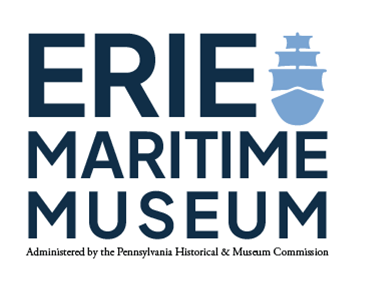Davidson’s Masterpiece
Graciously Donated to the Erie Maritime Museum by : Maritime Collectors
Visitors to the Erie Maritime Museum are treated to a wide variety of interactive and stationary exhibits ranging from the gun deck of the US Brig Lawrence, exhibits highlighting Erie’s commercial fishing and shipbuilding industries, and even the Brig Niagara, herself. One thing is for certain, patrons of our gallery and ships will leave knowing at least something about Erie, Pennsylvania’s rich maritime heritage. One piece, in particular, showcases one of our region’s most defining stories - the epic climax of an Erie-built squadron on the other end of Lake Erie during the War of 1812.
With a passion for the sea and a deep understanding of sailing mechanics, Julian Oliver Davidson recreated monumental scenes of life at sea during the nineteenth century. Julian was born on December 17, 1853, in Cumberland, Maryland to Matthias Davidson and Harriet (nee Standish), four decades after the Battle of Lake Erie. His father, while Julian was still a boy, oversaw the construction of the Havana Railroad, a job which saw the father-son duo make several trips to Cuba. On their final trip, a severe storm caused the ship to wreck however, rather than quench his passion for the sea, it made him yearn for it even more.
At the age of 17, Julian joined the crew of Arizona, a side-wheel steamer contracted to travel to the Far East by way of the Suez Canal. It was here that Julian began to learn the technical aspects of the maritime trades - how ships worked, sailed, and rigged. Eventually, Davidson returned to the United States, settling in New York City, and began to pursue a career in art. To the trained eye, one can easily see the different schools of maritime art. In the few years following his return to the United States, Davidson began to learn under the tutelage of Dutch artist Mauritz de Haas.
The Fine Art Dealers Association describes Davidson as, “one of the nineteenth centuries premier maritime artists”. Others describe him as an expert in multi-ship paintings, merging multiple schools of maritime art into masterpieces like The Battle of Lake Erie - now on display at the Erie Maritime Museum. Davidson was notorious for spending a great deal of time researching for his artwork. This is evident in this defining work.
The painting captures the climax of this famed battle at Put-In-Bay. At 14:40 (2:40 pm) Perry stated, “[he was] determined to pass through the Enemy’s line; bore up and passed ahead of their two Ships and a Brig, giving a raking fire to them from the Starboard guns, and to a large Schooner and Sloop from the [port] side.” Davidson captured this brilliantly - even going as far as to depict the appropriate angle of the sun’s rays on the sails of the ships. The details are impeccably captured on the canvas. Shots ring out of the fighting tops from Marines, shot rips across the water and into hulls while sails are dotted with holes. More beautifully, however, Perry’s blue battle flag, emblazoned with the dying words of Captain James Lawrence, “don’t give up the ship”, triumphantly flies high above the decks of Niagara.
Davidson worked on this particular piece from 1885-1887. It still is not known how Davidson was able to research and paint the Niagara in 1884-87 with such detail and complexity, given the fact that due to rotting timber and lack of funds, the brig had been scuttled in Misery Bay in 1820 and was not raised until 1913. What is known is that Davidson was himself an excellent sailor and that his naval experience, coupled with long years of prodigious research, infuses his masterful work with unmatched authority.
Julian Oliver Davidson
For over twenty years, this painting was loaned to us from our friends at the Maritime Collectors however, the painting has been graciously donated to the Museum, making it the “newest” item in our collection. Please stay tuned to our website as we begin to add more information about this beautiful piece to our digital museum.





